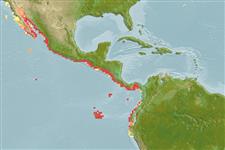>
Carangiformes (Jacks) >
Carangidae (Jacks and pompanos) > Caranginae
Etymology: Caranx: French, carangue, the name of a Caribbean fish; 1836 (Ref. 45335).
More on author: Günther.
Environment: milieu / climate zone / depth range / distribution range
Écologie
marin; saumâtre; profondeur 3 - 100 m (Ref. 9283). Subtropical; 34°N - 7°S, 121°W - 70°W
Eastern Pacific: Santa Cruz Island, California, USA to Peru, including the Gulf of California and the Galapagos Islands.
Length at first maturity / Taille / Poids / Âge
Maturity: Lm 26.5, range 17 - ? cm
Max length : 55.0 cm FL mâle / non sexé; (Ref. 9283); common length : 40.0 cm FL mâle / non sexé; (Ref. 9283); poids max. publié: 2.8 kg (Ref. 40637); âge max. reporté: 8 années (Ref. 127563)
Rayons mous dorsaux (Total): 18-21; Épines anales 3; Vertèbres: 25
Adults are found on the continental shelf, generally near the coast but also in deeper waters; penetrated estuaries (Ref. 9283). They feed mainly on silver-colored fishes, but also take squids, shrimps and other invertebrates (Ref. 9283). Juveniles are often found in estuarine waters (Ref. 9283). Marketed fresh, salted or dried, and smoked; also utilized as fishmeal and source of oil (Ref. 9283).
Eschmeyer, W.N., E.S. Herald and H. Hammann, 1983. A field guide to Pacific coast fishes of North America. Boston (MA, USA): Houghton Mifflin Company. xii+336 p. (Ref. 2850)
Statut dans la liste rouge de l'IUCN (Ref. 130435)
Menace pour l'homme
Harmless
Utilisations par l'homme
Pêcheries: commercial
Plus d'informations
RéférencesAquacultureProfil d'aquacultureSouchesGénétiqueElectrophoresesHéritabilitéPathologiesTraitementNutrientsMass conversion
Outils
Articles particuliers
Télécharger en XML
Sources Internet
Estimates based on models
Preferred temperature (Ref.
123201): 18.1 - 28.9, mean 25.5 °C (based on 100 cells).
Phylogenetic diversity index (Ref.
82804): PD
50 = 0.5000 [Uniqueness, from 0.5 = low to 2.0 = high].
Bayesian length-weight: a=0.01905 (0.01065 - 0.03411), b=2.97 (2.82 - 3.12), in cm total length, based on LWR estimates for this species & Genus-body shape (Ref.
93245).
Niveau trophique (Ref.
69278): 4.1 ±0.54 se; based on food items.
Résilience (Ref.
120179): Milieu, temps minimum de doublement de population : 1,4 à 4,4 années (Preliminary K or Fecundity.).
Fishing Vulnerability (Ref.
59153): Moderate vulnerability (35 of 100).
Nutrients (Ref.
124155): Calcium = 45.3 [18.4, 94.3] mg/100g; Iron = 0.771 [0.380, 1.666] mg/100g; Protein = 20.5 [18.1, 23.1] %; Omega3 = 0.397 [0.207, 0.755] g/100g; Selenium = 23.5 [10.1, 58.2] μg/100g; VitaminA = 10 [3, 30] μg/100g; Zinc = 0.473 [0.289, 0.759] mg/100g (wet weight);
